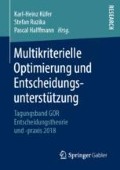Zusammenfassung
How to elicit risk preferences is an important question for explaining and predicting human decision behaviour. We provide an overview of elicitation methods and, then, focus on the midpoint chaining method. Within this method, subjects successively specify certainty equivalents for lotteries with two outcomes and the corresponding utility value is calculated. More and more supporting points for the utility function can be integrated and should result in a finer description of subjects risk preferences. We conduct an experiment to test the midpoint chaining method and, hereby, apply an incentive compatible procedure to measure risk preferences. The experimental results show that the more certainty equivalents are integrated, the less consistent are the predicted choices compared to real choices. However, it is possible to explain mean behaviour by adopting the idea of a finest perceived value when estimating numbers according to prominence theory. The finest perceived value is defined on the base of the outcome range and is used as divisibility condition. If this simplification takes place, imprecise supporting points for the utility function are elicited by the midpoint chaining method. More consistent results are obtained by parameterizing the utility function and using only one certainty equivalent to estimate the utility function.
Access this chapter
Tax calculation will be finalised at checkout
Purchases are for personal use only
Preview
Unable to display preview. Download preview PDF.
Literatur
[1] C. Köster, H. Schenk-Mathes, D.Wagner, Elicitation of risk preferences: Complexity versus accuracy, in: H. Schenk-Mathes, C. Köster (Eds.), Entscheidungstheorie- und Praxis, SpringerGabler, 2015, pp. 137–160.
[2] G. Charness, U. Gneezy, A. Imas, Experimental methods: Eliciting risk preferences, Journal of Economic Behavior & Organization 87 (2013) 43–51.
[3] R. Krzysztofowicz, Strength of preferences and risk attitude in utility measurement, Organizational Behavior and Human Performance 31 (1) (1983) 88–113.
[4] P. H. Farquhar, State of the artutility assessment methods, Management science 30 (11) (1984) 1283–1300.
[5] C. A. Holt, S. K. Laury, Risk aversion and incentive effects, American economic review 92 (5) (2002) 1644–1655.
[6] H. P. Binswanger, Attitudes toward risk: Experimental measurement in rural india, American journal of agricultural economics 62 (3) (1980) 395–407.
[7] H. P. Binswanger, Attitudes toward risk: Theoretical implications of an experiment in rural india, The Economic Journal 91 (364) (1981) 867–890.
[8] C. C. Eckel, P. J. Grossman, Sex differences and statistical stereotyping in attitudes toward financial risk, Evolution and human behavior 23 (4) (2002) 281–295.
[9] C. C. Eckel, P. J. Grossman, Forecasting risk attitudes: An experimental study using actual and forecast gamble choices, Journal of Economic Behavior & Organization 68 (1) (2008) 1–17.
[10] U. Gneezy, J. Potters, An experiment on risk taking and evaluation periods, The Quarterly Journal of Economics 112 (2) (1997) 631–645.
[11] C. W. Lejuez, J. P. Read, C. W. Kahler, J. B. Richards, S. E. Ramsey, G. L. Stuart, D. R. Strong, R. A. Brown, Evaluation of a behavioral measure of risk taking: the balloon analogue risk task (bart)., Journal of Experimental Psychology: Applied 8 (2) (2002) 75.
[12] G. Wagner, J. Frick, J. Schupp, The german socio-economic panel study (soep)-evolution, scope and enhancements.
[13] A. Saha, Expo-power utility: A flexibleform for absolute and relative risk aversion, American Journal of Agricultural Economics 75 (4) (1993) 905–913.
[14] D. Kahneman, A. Tversky, Prospect theory: An analysis of decision under risk, Econometrica 47 (1979) 263–291.
[15] W. Albers, Prominence theory as a tool to model boundedly rational decisions, in: G. Gigerenzer, R. Selten (Eds.), Bounded rationality: The adaptive toolbox, MIT Press, 2001, pp. 297–317.
[16] W. Albers, Evaluation of lotteries with two alternatives by the theory of prominence a normative benchmark of risk neutrality that predicts median behavior of subjects, Tech. rep., University of Bielefeld (1998).
[17] C. Keser, B. Vogt, et al., Why do experimental subjects choose an equilibrium which is neither Payoff nor Risk dominant?, CIRANO, 2000.
Author information
Authors and Affiliations
Corresponding author
Editor information
Editors and Affiliations
Rights and permissions
Copyright information
© 2019 Springer Fachmedien Wiesbaden GmbH, ein Teil von Springer Nature
About this chapter
Cite this chapter
Köster, C., Schenk-Mathes, H. (2019). Incentive Compatible Procedure to Measure Risk Preferences: Adequacy of the Midpoint Chaining Method. In: Küfer, KH., Ruzika, S., Halffmann, P. (eds) Multikriterielle Optimierung und Entscheidungsunterstützung. Springer Gabler, Wiesbaden. https://doi.org/10.1007/978-3-658-27041-4_8
Download citation
DOI: https://doi.org/10.1007/978-3-658-27041-4_8
Published:
Publisher Name: Springer Gabler, Wiesbaden
Print ISBN: 978-3-658-27040-7
Online ISBN: 978-3-658-27041-4
eBook Packages: Business and Economics (German Language)

